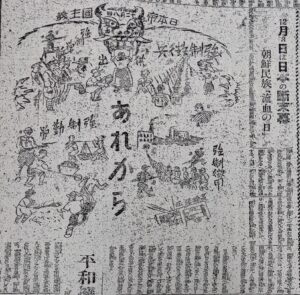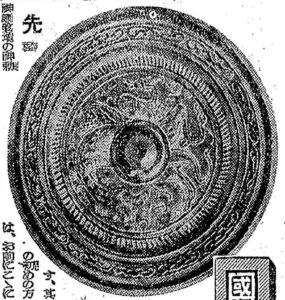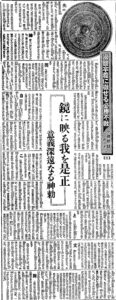For this post, I am examining two wartime propaganda articles to explore the hierarchical administrative structure that Imperial Japan used to forcibly and systematically indoctrinate all of Korea into becoming Japanese. During the final years of Imperial Japanese colonial rule over Korea, the Governor-General’s Office in Seoul frequently invoked the slogan “末端滲透” (mattan shintō)—“grassroots penetration.” This was not only about exerting the central government's authority in rural areas, but also about ideologically cleansing the countryside, where ordinary Korean villagers were still largely hostile to Imperial Japanese ideology and refused to identify as loyal “imperial subjects.”
To address this perceived shortcoming, the colonial government launched a coordinated campaign to send officials from Seoul out into the countryside to personally embed themselves in township (myeon, 面) offices. These officials were following the example of Governor-General Koiso, who made a spectacle of traveling to rural areas and holding face-to-face meetings with local officials in his much-publicized inspection tours of rural Korea.
The officials would travel to remote townships, live for several days inside the township office, and work alongside the local myeon leader and staff. They were there not only to provide “administrative guidance,” but to indoctrinate the township leaders with wartime ideology: mandatory Shinto religious observance, pushing for agricultural overproduction, enforcing conscription, and encouraging compulsory savings (see 1944 article below). During the inspection tours, Koiso asked the local myeon (township) leader in Gapyeong whether he had been conducting “rensei” (錬成, “training”), which was a euphemism for ideological indoctrination: compulsory bowing toward the Imperial Palace every morning, mandatory visits to Shinto shrines, adoption of Japanese language, Shinto purification rituals like misogi, and other practices intended to transform Koreans into loyal imperial subjects.
From there, the expectation was that the indoctrinated myeon leader would spread these same ideas down the chain—to hamlet (ri) leaders within the township, who would then indoctrinate their own village residents (see 1943 article below). In theory, this trickle-down approach could have transformed the Korean countryside into a loyal outpost of Imperial Japan, but it did not work that way. The Japanese authorities underestimated the resilience of Korean national identity, language, and cultural autonomy.
The indoctrinated myeon leader would have also been trained by the Seoul officials into techniques to persuade villagers into providing as much grain as possible to the Imperial Army. This 1944 article illustrates how the myeon leader may have overseen some horrific scenes of hardship and starvation as local farmers worked day and night, even cutting into their own personal grain supplies to meet the ambitious quotas imposed by the Imperial Army.
The colonial regime had mechanisms in place to try to ensure ideological compliance even after central officials left. Governor Koiso encouraged hamlet leaders to bypass the township chief and report directly to higher authorities like the county leader or police chief if they believed their myeon leader was not sufficiently loyal. This created a culture of surveillance and snitching, ensuring that everyone—from the top down—was watching each other for signs of ideological weakness. This was what “grassroots penetration” meant in practice: an oppressive system of top-down ideological enforcement, staged in the name of unity with Imperial Japan.
TL;DR: In 1943–44, Governor-General Koiso launched a top-down “grassroots penetration” (末端浸透) campaign of indoctrinating the Korean people in wartime Imperialist ideology and boost agricultural production. Seoul officials would tour the entire country and visit each township for a few days at a time to indoctrinate the township leaders, the township leaders would visit each hamlet to indoctrinate the hamlet leaders, and finally the hamlet leaders would indoctrinate the villagers.
[Translation]
Gyeongseong Ilbo (Keijo Nippo) March 4, 1944
Devoted Service Deep in the Mountains
Bureau of Rural Affairs Chiefs Carry Out Grassroots Administration
The grassroots penetration of government administration, such as the delivery of agricultural products and other goods, encouragement of savings, and conscription procedures, is becoming increasingly important. Governor-General Koiso has continued to emphasize this at every opportunity.
In response, the Bureau of Local Affairs of the Government-General has dispatched a team of approximately ten staff members, including Chief Ōkubo, Administrative Officer Murakami, and Director Tanaka. Beginning on February 7, 1944, they embarked on a direct field survey of the realities of rural administration.
This initiative is not a conventional inspection or mere investigation. Rather, the officials are residing and working at township (myeon) offices, quietly carrying out duties themselves. By leading through action rather than words, they are teaching myeon officials administrative tasks and working to deepen their awareness of the wartime situation.
For instance, two days after leaving Sinuiju, Director Tanaka has already gone to the myeon office in Oksang-myeon (옥상면, 玉尚面), Uiju County, located thirty ri (approximately 12 kilometers) into the mountains of Uiju in North Pyongan Province. He stayed at the myeon office for one week, personally taking on the tasks of the myeon chief and clerks, cutting ration tickets, and leading by example in guiding the staff at the myeon office, all while closely observing actual conditions.
Administrative Officer Murakami is currently deployed to Ongjin County in Hwanghae Province, and other personnel are likewise active in Bocheon-myeon (보천면, 普天面) in South Hamgyeong Province, and Seosan County in South Chungcheong Province.
Chief Ōkubo will soon make an official visit as well, but in Seosan County, there is even a report that local villagers, moved by seeing central government officials taking the initiative to shovel snow, offered a small token of appreciation in gratitude.
In mountain villages where central government officials had never previously set foot, both myeon office staff and local residents have been greatly moved. Their recognition of the wartime situation has deepened significantly, and the campaign is yielding considerable positive results.
Gyeongseong Ilbo (Keijo Nippo) October 13, 1943
Governance that “Lives Together with the Residents”
Government-General Studies Permanent Residency of Township Staff in Hamlets
Reform of Grassroots Administrative Structure
With the establishment of new food departments in each province, the intensification of production, labor reinforcement measures, and institutions such as the Korea Research Institute, the decisive war structure of the embattled Korean Peninsula is moving forward ever more aggressively on all fronts. Governor-General Koiso’s vision is becoming increasingly sharpened and concrete. All twenty-five million people of the Korean peninsula are hastening to their respective positions on the battlefront of production as vanguard warriors.
However, unless these policies penetrate thoroughly into the very grassroots, their effectiveness will be incomplete. Governor-General Koiso has repeatedly emphasized this point. At a time when this necessity is becoming ever more pressing, the Government-General is responding by initiating reforms of the grassroots administrative machinery, and under the direction of Chief of Civil Affairs Tanaka, is undertaking a careful study.
Specifically, this refers to the organizational reform of township (myeon) offices. At the core of this reform is the idea previously expressed by the Chief of Civil Affairs: “Permanent residency of myeon officials in hamlets.”
That is, mid-level myeon officials would be assigned to hamlets—one or two officials per hamlets—where they would reside, dive into the hearts of the farming communities, and conduct administrative duties. They would share in the daily life of the villagers, morning and evening, while providing guidance and encouragement in all areas such as food production increases, food contributions, food storage, and resource collection. This system aims to reinforce the penetration of administrative functions to the grassroots level.
[Transcription]
京城日報 1944年3月4日
山奥に挺身執務
府地方課長ら末端行政
農作物その他の供出、貯蓄奨励、徴兵事務など行政の末端滲透は益益重要となっており、小磯総督も機会ある度に強調しているが、総督府地方課は大久保課長、村上事務官、田中理事官以下約十名の職員が出動し去る二月七日から地方行政の実態調査に乗り出しているが、之は従来の査察とか、単なる調査ではなく、職員が面事務所で起居し自ら黙々と執務し、口先きのみでなく身をもって面職員に事務を教え、或は時局認識の徹底を図っているもので、既に田中理事官は新義州から二日間、義州から三十里の山奥である平北道義州郡玉尚面の面事務所に約一週間泊り込み、面長の仕事、書記の事務を執ったり配給票を切ったり、率先して面職員を指導する傍ら実態を調査しており、村上事務官も目下黄海道甕津郡に出動しており、その他の職員は咸南道普天面や忠南道瑞山郡等にも出動中で、近く大久保課長も出張するが、瑞山郡では本府職員が率先して雪かきを行っているのを部落民が見て若干の謝礼金をだしたという事実もあり、かつて本府職員が行ったこともない山奥の面では、面職員をはじめ部落民が非常に感激し時局の認識も深め多大の効果を挙げつつある。
京城日報 1943年10月13日
住民と共に生きる政治
本府面職員の部落常駐を研究
末端行政機構改革
各道食糧部の新設、生産増強、労務強化対策、朝鮮研究所等々戦う半島の決戦体制は各面に亘り愈々強行進軍を開始し小磯理念は益々鋭く具体化しており、二千五百万の半島民衆は生産戦の尖兵として一人残らず戦闘配置に急いでいるが、これらの施策が更に徹底的に末端へ滲透しなければならぬことは小磯総督が幾度か強調したことであり、その要は加速度的に重要化しているとき総督府ではこれに対応し末端行政機構の改革に着手。田中政務総監の手もとで慎重に検討している。
即ち面事務所の機構改革がそれであるが、これはかつて政務総監が語った『面職員の部落常駐』がその骨子となっているもので、面の中堅職員が一部落に一、二人が居を構え農民の懐ろに飛び込んで事務を執り朝、夕起居を共にし、食糧の増産に供出に貯蓄に資源回収にと凡ゆる面に亘り指導督励に当らんとするものであり、これにより行政の末端滲透を強化せんとするものである。
Source: Source: National Library of Korea, Digital Newspaper Archive
See also:
- Koiso’s 1943 ‘Great Leader’ Strongman Tours: Surprise village inspections to intimidate local leaders and impose Japanese language and culture all over the Korean countryside (link)
-
Korean rice farmers barely survived eating grass roots as they worked tirelessly to meet the rice quotas imposed by the Imperial Army in 1944, even sacrificing their own personal rice supplies to face starvation under pressure from the police inspector and the township chief (link)















